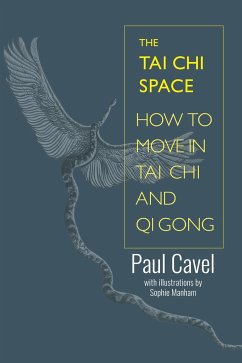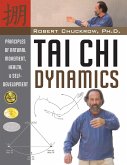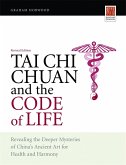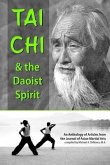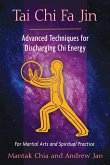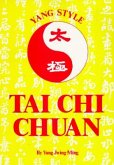- Broschiertes Buch
- Merkliste
- Auf die Merkliste
- Bewerten Bewerten
- Teilen
- Produkt teilen
- Produkterinnerung
- Produkterinnerung
Learn the forty-two essential principles of Tai Chi & Qi Gong
Andere Kunden interessierten sich auch für
![Tai CHI Dynamics Tai CHI Dynamics]() Robert ChuckrowTai CHI Dynamics21,99 €
Robert ChuckrowTai CHI Dynamics21,99 €![108 Insights Into Tai Chi Chuan 108 Insights Into Tai Chi Chuan]() Michael Gilman108 Insights Into Tai Chi Chuan12,99 €
Michael Gilman108 Insights Into Tai Chi Chuan12,99 €![101 Reflections on Tai Chi Chuan 101 Reflections on Tai Chi Chuan]() Michael Gilman101 Reflections on Tai Chi Chuan12,99 €
Michael Gilman101 Reflections on Tai Chi Chuan12,99 €![Tai CHI Chuan and the Code of Life Tai CHI Chuan and the Code of Life]() Graham HorwoodTai CHI Chuan and the Code of Life35,99 €
Graham HorwoodTai CHI Chuan and the Code of Life35,99 €![Tai Chi and the Daoist Spirit Tai Chi and the Daoist Spirit]() Dennis Willmont L AcTai Chi and the Daoist Spirit31,99 €
Dennis Willmont L AcTai Chi and the Daoist Spirit31,99 €![Tai CHI Fa Jin Tai CHI Fa Jin]() Mantak ChiaTai CHI Fa Jin25,99 €
Mantak ChiaTai CHI Fa Jin25,99 €![Yang Style Tai Chi Chuan Yang Style Tai Chi Chuan]() Yang Jwing-MingYang Style Tai Chi Chuan13,99 €
Yang Jwing-MingYang Style Tai Chi Chuan13,99 €-
-
-
Learn the forty-two essential principles of Tai Chi & Qi Gong
Hinweis: Dieser Artikel kann nur an eine deutsche Lieferadresse ausgeliefert werden.
Hinweis: Dieser Artikel kann nur an eine deutsche Lieferadresse ausgeliefert werden.
Produktdetails
- Produktdetails
- Verlag: Aeon Books Ltd
- Seitenzahl: 144
- Erscheinungstermin: 4. Oktober 2017
- Englisch
- Abmessung: 228mm x 151mm x 17mm
- Gewicht: 247g
- ISBN-13: 9781904658986
- ISBN-10: 1904658989
- Artikelnr.: 48063531
- Herstellerkennzeichnung
- Libri GmbH
- Europaallee 1
- 36244 Bad Hersfeld
- gpsr@libri.de
- Verlag: Aeon Books Ltd
- Seitenzahl: 144
- Erscheinungstermin: 4. Oktober 2017
- Englisch
- Abmessung: 228mm x 151mm x 17mm
- Gewicht: 247g
- ISBN-13: 9781904658986
- ISBN-10: 1904658989
- Artikelnr.: 48063531
- Herstellerkennzeichnung
- Libri GmbH
- Europaallee 1
- 36244 Bad Hersfeld
- gpsr@libri.de
Paul Cavel is the founder and principal of The Tai Chi Space, a London-based school established to teach Water method arts. Since 1987 Paul has studied Taoism, the I Ching, Five Element nei gong, medical qi gong, Yang and Wu style tai chi, Pre- and Post-birth bagua, yoga, tui na energy healing and Taoist meditation. Paul is a certified soft tissue and injury therapist (ITEC Level 4), editor of the Inner Quest journal and he holds a mechanical engineering certificate from London City and Guilds. He began teaching internal energy arts in 1995 with the encouragement of his primary teacher, after healing himself from a serious motorcycle accident.
About the Author
About the Artist
Acknowledgements
Foreword by Michael Mettner
Introduction
All Forms Are Not Created Equal
Myth Is an Image
Journey towards Unity
Through the Eyes of the Ancients
How Principles Are Presented
Three Stages for Embodying Internal Principles
Why Use Tai Chi Postures?
Visual Lexicon
Who Can Benefit from This Book?
Creating a Practice Microcosm
Part 1 Fundamental Principles: Nuts and Bolts
Principle 1: Cultivate the Arts
Separate and Combine
Cyclic Training
Principle 2: The Rule of Third
Principle 3: Become Sung
Principle 4: Build the Pyramid of Giza
11 Steps to Good Posture
Principle 5: Breathe with the Diaphragm
Principle 6: The Mind's Focus
Principle 7: Grow Your Root
Phase 1: Plant Your Feet and Sink Your Qi
Phase 2: Release Tension to Develop Your Root
Principle 8: Moving in Three-Dimensional Space
Principle 9: Arms Are Led by Hands and Wrists
Principle 10: Create Circular Motion
Principle 11: Water Doesn't Flow through a Kinked Hose
Principle 12: Shifting Weight Is Like Walking Upstairs
Principle 13: The Body Turns Like a Revolving Door
Principle 14: The Down Creates the Up
Principle 15: Move Like a Puppet on a String
Principle 16: Don't Play the Juggler
The Five Primary Principles
Part 2 Internal Principles for Connectivity and Flow
Principle 17: Warm Up Body and Mind
Beginning Form
Principle 18: The Body Operates Like the Powertrain of a Car
Peng (Ward Off)
Principle 19: Soften to Close, Release to Open
Lu (Roll Back) and Ji (Press)
Principle 20: The Body Makes Use of Anchors
An (Push)
Principle 21: Opposites Spread Open the Body
Single Whip
Principle 22: Grow Like a Tree
Lift Hands
Principle 23: The Six Connections
Shoulder Strike
Principle 24: Tune in to Heaven Above and Earth Below
White Crane Spreads Its Wings
Principle 25: Create Balanced Openings
Brush Knee
Principle 26: The Continuum of Empty versus Full
Play Guitar (Play the Lute)
Principle 27: All Body Parts Move Like a Swiss Clock
Step Forward, Parry and Punch
Principle 28: Balance Yin and Yang Energies
Apparent Close Up
Principle 29: The Body Moves in Circles
Cross Hands
Part 3 Deeper Principles for Fluidity and Energy Development
Principle 30: Generate Internal Momentum
Embrace the Tiger, Return to the Mountain
Principle 31: Turbine Power Eradicates Inertia
Fist under Elbow
Principle 32: Swing the Pendulum
Repulse Monkey
Principle 33: Spring the Five Bows
Slanted Flying
Principle 34: Unify the Yin Snake and the Yang Crane
White Crane Spreads Its Wings
Principle 35: Sinking Creates Rising
Needle at Sea Bottom and Fan through Back
Principle 36: Energy Moves Fluids, Fluids Nourish the Body
Turn and Chop with the Fist
Principle 37: Balance the Sphere
Lu and Ji
Principle 38: Become a Sandbag
Single Whip
Principle 39: Ride the Wave
Waving Hands Like Clouds
Principle 40: Moving into Stillness
Single Whip
Principle 41: Gather and Bank
Closing Form
Principle 42: Postures Link into Fluid Forms
Afterword
Blood and Qi Are Inseparable
The Fabric of the Internal Arts
Practicalities
To Advance, First Retreat
Moving towards the Tai Chi Space
References
About the Artist
Acknowledgements
Foreword by Michael Mettner
Introduction
All Forms Are Not Created Equal
Myth Is an Image
Journey towards Unity
Through the Eyes of the Ancients
How Principles Are Presented
Three Stages for Embodying Internal Principles
Why Use Tai Chi Postures?
Visual Lexicon
Who Can Benefit from This Book?
Creating a Practice Microcosm
Part 1 Fundamental Principles: Nuts and Bolts
Principle 1: Cultivate the Arts
Separate and Combine
Cyclic Training
Principle 2: The Rule of Third
Principle 3: Become Sung
Principle 4: Build the Pyramid of Giza
11 Steps to Good Posture
Principle 5: Breathe with the Diaphragm
Principle 6: The Mind's Focus
Principle 7: Grow Your Root
Phase 1: Plant Your Feet and Sink Your Qi
Phase 2: Release Tension to Develop Your Root
Principle 8: Moving in Three-Dimensional Space
Principle 9: Arms Are Led by Hands and Wrists
Principle 10: Create Circular Motion
Principle 11: Water Doesn't Flow through a Kinked Hose
Principle 12: Shifting Weight Is Like Walking Upstairs
Principle 13: The Body Turns Like a Revolving Door
Principle 14: The Down Creates the Up
Principle 15: Move Like a Puppet on a String
Principle 16: Don't Play the Juggler
The Five Primary Principles
Part 2 Internal Principles for Connectivity and Flow
Principle 17: Warm Up Body and Mind
Beginning Form
Principle 18: The Body Operates Like the Powertrain of a Car
Peng (Ward Off)
Principle 19: Soften to Close, Release to Open
Lu (Roll Back) and Ji (Press)
Principle 20: The Body Makes Use of Anchors
An (Push)
Principle 21: Opposites Spread Open the Body
Single Whip
Principle 22: Grow Like a Tree
Lift Hands
Principle 23: The Six Connections
Shoulder Strike
Principle 24: Tune in to Heaven Above and Earth Below
White Crane Spreads Its Wings
Principle 25: Create Balanced Openings
Brush Knee
Principle 26: The Continuum of Empty versus Full
Play Guitar (Play the Lute)
Principle 27: All Body Parts Move Like a Swiss Clock
Step Forward, Parry and Punch
Principle 28: Balance Yin and Yang Energies
Apparent Close Up
Principle 29: The Body Moves in Circles
Cross Hands
Part 3 Deeper Principles for Fluidity and Energy Development
Principle 30: Generate Internal Momentum
Embrace the Tiger, Return to the Mountain
Principle 31: Turbine Power Eradicates Inertia
Fist under Elbow
Principle 32: Swing the Pendulum
Repulse Monkey
Principle 33: Spring the Five Bows
Slanted Flying
Principle 34: Unify the Yin Snake and the Yang Crane
White Crane Spreads Its Wings
Principle 35: Sinking Creates Rising
Needle at Sea Bottom and Fan through Back
Principle 36: Energy Moves Fluids, Fluids Nourish the Body
Turn and Chop with the Fist
Principle 37: Balance the Sphere
Lu and Ji
Principle 38: Become a Sandbag
Single Whip
Principle 39: Ride the Wave
Waving Hands Like Clouds
Principle 40: Moving into Stillness
Single Whip
Principle 41: Gather and Bank
Closing Form
Principle 42: Postures Link into Fluid Forms
Afterword
Blood and Qi Are Inseparable
The Fabric of the Internal Arts
Practicalities
To Advance, First Retreat
Moving towards the Tai Chi Space
References
About the Author
About the Artist
Acknowledgements
Foreword by Michael Mettner
Introduction
All Forms Are Not Created Equal
Myth Is an Image
Journey towards Unity
Through the Eyes of the Ancients
How Principles Are Presented
Three Stages for Embodying Internal Principles
Why Use Tai Chi Postures?
Visual Lexicon
Who Can Benefit from This Book?
Creating a Practice Microcosm
Part 1 Fundamental Principles: Nuts and Bolts
Principle 1: Cultivate the Arts
Separate and Combine
Cyclic Training
Principle 2: The Rule of Third
Principle 3: Become Sung
Principle 4: Build the Pyramid of Giza
11 Steps to Good Posture
Principle 5: Breathe with the Diaphragm
Principle 6: The Mind's Focus
Principle 7: Grow Your Root
Phase 1: Plant Your Feet and Sink Your Qi
Phase 2: Release Tension to Develop Your Root
Principle 8: Moving in Three-Dimensional Space
Principle 9: Arms Are Led by Hands and Wrists
Principle 10: Create Circular Motion
Principle 11: Water Doesn't Flow through a Kinked Hose
Principle 12: Shifting Weight Is Like Walking Upstairs
Principle 13: The Body Turns Like a Revolving Door
Principle 14: The Down Creates the Up
Principle 15: Move Like a Puppet on a String
Principle 16: Don't Play the Juggler
The Five Primary Principles
Part 2 Internal Principles for Connectivity and Flow
Principle 17: Warm Up Body and Mind
Beginning Form
Principle 18: The Body Operates Like the Powertrain of a Car
Peng (Ward Off)
Principle 19: Soften to Close, Release to Open
Lu (Roll Back) and Ji (Press)
Principle 20: The Body Makes Use of Anchors
An (Push)
Principle 21: Opposites Spread Open the Body
Single Whip
Principle 22: Grow Like a Tree
Lift Hands
Principle 23: The Six Connections
Shoulder Strike
Principle 24: Tune in to Heaven Above and Earth Below
White Crane Spreads Its Wings
Principle 25: Create Balanced Openings
Brush Knee
Principle 26: The Continuum of Empty versus Full
Play Guitar (Play the Lute)
Principle 27: All Body Parts Move Like a Swiss Clock
Step Forward, Parry and Punch
Principle 28: Balance Yin and Yang Energies
Apparent Close Up
Principle 29: The Body Moves in Circles
Cross Hands
Part 3 Deeper Principles for Fluidity and Energy Development
Principle 30: Generate Internal Momentum
Embrace the Tiger, Return to the Mountain
Principle 31: Turbine Power Eradicates Inertia
Fist under Elbow
Principle 32: Swing the Pendulum
Repulse Monkey
Principle 33: Spring the Five Bows
Slanted Flying
Principle 34: Unify the Yin Snake and the Yang Crane
White Crane Spreads Its Wings
Principle 35: Sinking Creates Rising
Needle at Sea Bottom and Fan through Back
Principle 36: Energy Moves Fluids, Fluids Nourish the Body
Turn and Chop with the Fist
Principle 37: Balance the Sphere
Lu and Ji
Principle 38: Become a Sandbag
Single Whip
Principle 39: Ride the Wave
Waving Hands Like Clouds
Principle 40: Moving into Stillness
Single Whip
Principle 41: Gather and Bank
Closing Form
Principle 42: Postures Link into Fluid Forms
Afterword
Blood and Qi Are Inseparable
The Fabric of the Internal Arts
Practicalities
To Advance, First Retreat
Moving towards the Tai Chi Space
References
About the Artist
Acknowledgements
Foreword by Michael Mettner
Introduction
All Forms Are Not Created Equal
Myth Is an Image
Journey towards Unity
Through the Eyes of the Ancients
How Principles Are Presented
Three Stages for Embodying Internal Principles
Why Use Tai Chi Postures?
Visual Lexicon
Who Can Benefit from This Book?
Creating a Practice Microcosm
Part 1 Fundamental Principles: Nuts and Bolts
Principle 1: Cultivate the Arts
Separate and Combine
Cyclic Training
Principle 2: The Rule of Third
Principle 3: Become Sung
Principle 4: Build the Pyramid of Giza
11 Steps to Good Posture
Principle 5: Breathe with the Diaphragm
Principle 6: The Mind's Focus
Principle 7: Grow Your Root
Phase 1: Plant Your Feet and Sink Your Qi
Phase 2: Release Tension to Develop Your Root
Principle 8: Moving in Three-Dimensional Space
Principle 9: Arms Are Led by Hands and Wrists
Principle 10: Create Circular Motion
Principle 11: Water Doesn't Flow through a Kinked Hose
Principle 12: Shifting Weight Is Like Walking Upstairs
Principle 13: The Body Turns Like a Revolving Door
Principle 14: The Down Creates the Up
Principle 15: Move Like a Puppet on a String
Principle 16: Don't Play the Juggler
The Five Primary Principles
Part 2 Internal Principles for Connectivity and Flow
Principle 17: Warm Up Body and Mind
Beginning Form
Principle 18: The Body Operates Like the Powertrain of a Car
Peng (Ward Off)
Principle 19: Soften to Close, Release to Open
Lu (Roll Back) and Ji (Press)
Principle 20: The Body Makes Use of Anchors
An (Push)
Principle 21: Opposites Spread Open the Body
Single Whip
Principle 22: Grow Like a Tree
Lift Hands
Principle 23: The Six Connections
Shoulder Strike
Principle 24: Tune in to Heaven Above and Earth Below
White Crane Spreads Its Wings
Principle 25: Create Balanced Openings
Brush Knee
Principle 26: The Continuum of Empty versus Full
Play Guitar (Play the Lute)
Principle 27: All Body Parts Move Like a Swiss Clock
Step Forward, Parry and Punch
Principle 28: Balance Yin and Yang Energies
Apparent Close Up
Principle 29: The Body Moves in Circles
Cross Hands
Part 3 Deeper Principles for Fluidity and Energy Development
Principle 30: Generate Internal Momentum
Embrace the Tiger, Return to the Mountain
Principle 31: Turbine Power Eradicates Inertia
Fist under Elbow
Principle 32: Swing the Pendulum
Repulse Monkey
Principle 33: Spring the Five Bows
Slanted Flying
Principle 34: Unify the Yin Snake and the Yang Crane
White Crane Spreads Its Wings
Principle 35: Sinking Creates Rising
Needle at Sea Bottom and Fan through Back
Principle 36: Energy Moves Fluids, Fluids Nourish the Body
Turn and Chop with the Fist
Principle 37: Balance the Sphere
Lu and Ji
Principle 38: Become a Sandbag
Single Whip
Principle 39: Ride the Wave
Waving Hands Like Clouds
Principle 40: Moving into Stillness
Single Whip
Principle 41: Gather and Bank
Closing Form
Principle 42: Postures Link into Fluid Forms
Afterword
Blood and Qi Are Inseparable
The Fabric of the Internal Arts
Practicalities
To Advance, First Retreat
Moving towards the Tai Chi Space
References

